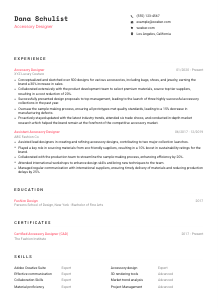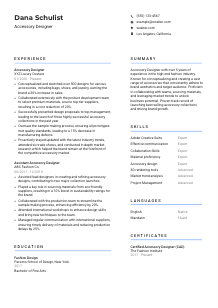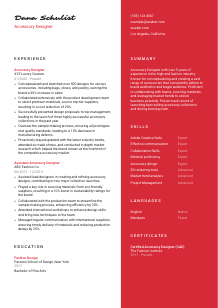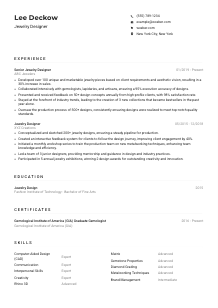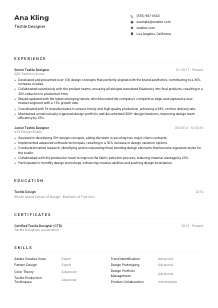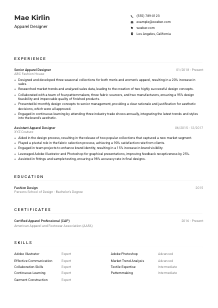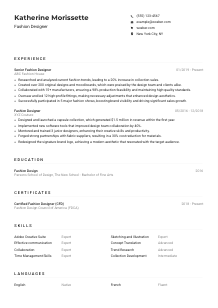Accessory Designer Resume Example
Jazzing up garments, but your resume seems under-accessorized? Splice your style with this Accessory Designer resume example, crafted using Wozber free resume builder. Uncover how to thread your design flair with job demands, so your career accessory collection is always a perfect match!
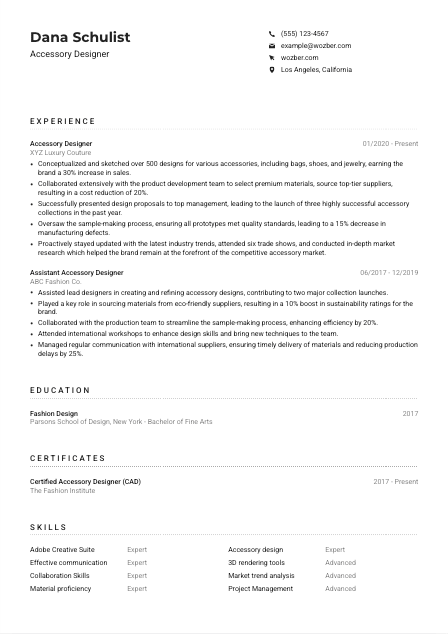
How to write an Accessory Designer Resume?
Are you eyeing a sparkling career in Accessory Design and ready to transfuse your portfolio with that extra dazzle that lands you your dream role? Drawing on the fine line between creativity and market demands can seem like weaving delicate lace, yet this challenge is what makes an Accessory Designer's resume a masterpiece. Leveraging Wozber's free resume builder, let's embark on a bespoke journey to tailor your resume with precision, ensuring it's not only ATS-compliant but a true reflection of your design prowess and industry acumen.
Personal Details
The Personal Details section might appear straightforward, yet it's where your individual brand starts to sparkle. Think of it as laying down the first piece of fabric onto your design; you want it to stand out. Let's tailor this piece with utmost care, keeping it professional while ensuring it resonates with the glamorous world of Accessory Design.
1. Spell Your Name With Style
Your name is not just a tag; it's the label of your brand. Opt for a font that's legible yet has personality. Playing with typography here is like choosing the perfect clasp for a handbag – it pulls everything together.
2. Tailor Your Title
Under your name, stitch your desired position title, "Accessory Designer," as if embroidering your aspirations directly onto the fabric of your resume. It's a precise echo of what the hiring team seeks, making it instantly clear you're cut out for the role.
3. Essential Contact Fabrics
Weave in your most accessible contact information but ensure the thread count is high on professionalism – think firstname.lastname@email.com for your email. It's like selecting a high-grade leather; details matter.
4. Location, Location, Location
"Must be located in Los Angeles, California" – this line from the job description isn't just a detail; it's a requirement. Seamlessly incorporate your Los Angeles credentials to confirm you're in the right fashion district, no relocation necessary.
5. A Dash of Professional Online Presence
Consider your LinkedIn profile as your online portfolio; make sure it's as curated and detailed as your sketches. If you have a professional website showcasing your designs, include it. It's the equivalent of offering a lookbook alongside your resume.
Takeaway
Think of the personal details section as the initial sketch of your resume; it sets the tone for everything that follows. Ensure every detail is tailored to present you as the ideal candidate, not just on paper, but in the digital world too. First impressions in fashion and resumes are everything; make it count.





Experience
The experience section is where your resume starts to take shape, telling the story of your journey in the world of accessories. Like adding layers to a garment, each role you've played adds depth, texture, and color to your career narrative.
- Conceptualized and sketched over 500 designs for various accessories, including bags, shoes, and jewelry, earning the brand a 30% increase in sales.
- Collaborated extensively with the product development team to select premium materials, source top‑tier suppliers, resulting in a cost reduction of 20%.
- Successfully presented design proposals to top management, leading to the launch of three highly successful accessory collections in the past year.
- Oversaw the sample‑making process, ensuring all prototypes met quality standards, leading to a 15% decrease in manufacturing defects.
- Proactively stayed updated with the latest industry trends, attended six trade shows, and conducted in‑depth market research which helped the brand remain at the forefront of the competitive accessory market.
- Assisted lead designers in creating and refining accessory designs, contributing to two major collection launches.
- Played a key role in sourcing materials from eco‑friendly suppliers, resulting in a 10% boost in sustainability ratings for the brand.
- Collaborated with the production team to streamline the sample‑making process, enhancing efficiency by 20%.
- Attended international workshops to enhance design skills and bring new techniques to the team.
- Managed regular communication with international suppliers, ensuring timely delivery of materials and reducing production delays by 25%.
1. Dissect Job Requirements
Break down the given job description meticulously. Highlighting phrases like "conceptualize and sketch designs" or "collaborate with the product development team" gives you keywords to weave into your story of past roles.
2. Reflect Reality in Roles
List your roles in reverse chronological order, like arranging a display from the newest collection to the classics. For each position, always list your job title first, followed by the company's name and the dates of your runway show – we mean, employment.
3. Craft Achievements With Precision
Detail your contributions with the finesse of a fine jeweler setting stones. For instance, "Conceptualized and sketched over 500 designs" not only shows volume but hints at your creative endurance and diversity.
4. Embellish With Numbers
Numbers in your achievements are like sequins sewn onto a garment – they catch the eye. Whether it's a sales increase percentage or the number of successful collections launched, these figures tell a compelling story of your impact.
5. Curate to the Couture
Keep the focus sharp, like a well-cut diamond. Every element in this section should reflect the job requirements. Non-relevant experiences, no matter how proud you are of them, should be left off the worktable.
Takeaway
Your experience section embodies the craft and creativity you bring to the accessory design world. Consider each bullet point a stitch in your career's fabric, each one deliberately placed to showcase your most exquisite work and achievements. Be bold, be detailed, and above all, ensure each word reflects your dedication to design excellence.
Education
While the world of fashion may often prioritize experience and portfolio, a well-drawn education section adds foundational strength to your resume, much like the structure of a finely crafted shoe.
1. Highlight the Premiere Fabric
Start with the premium material: your degree. The job sought a "Bachelor's degree in Fashion Design or related field." Make sure this is prominently displayed, as luxurious as the main material of your finest accessory design.
2. Weave in Your Alma Mater
List the institution where you honed your craft, akin to selecting a fabric source. Whether it's a renowned design school or a hidden gem, it's part of your unique blueprint as a designer.
3. Pattern Your Achievements
If your education journey includes standout moments like scholarships, awards, or leadership in fashion-related societies, include these as delicate embellishments that add character and depth to your educational narrative.
4. Cut and Trim to Fit
For roles requiring extensive experience, the education section can be more succinct, focusing on the highest degrees or most relevant courses. Tailor this section as you would adjust a pattern – keeping what enhances the overall design and setting aside the rest.
5. Reflect on Continuous Learning
The fashion industry never stands still, and neither should your education section. If you've taken part in recent workshops or courses to refine your skills in Adobe Creative Suite or 3D rendering tools, for instance, it's worth mentioning. Continuous learning shows a commitment to keeping your designs fresh and innovative.
Takeaway
Like every stitch in a garment, the education section of your resume contributes to the overall impression you create. It's a testament to your technical skillset, creativity, and commitment to the craft of accessory design. Shape it with care to ensure it supports and enhances your professional narrative.
Certificates
Certificates in the fashion industry can be like limited-edition collaborations: they showcase your niche skills, dedication to your craft, and willingness to keep pace with industry trends.
1. Select Your Showpieces
Just as accessories complete an outfit, the right certificates complete your resume. Choose those most relevant to an accessory design role, such as a "Certified Accessory Designer (CAD)" credential. This demonstrates you're not just keeping up with trends; you're certified in creating them.
2. Spotlight the New Arrivals
Newly acquired certificates or those that are industry-recognized deserve the spotlight. They're like the must-have accessory of the season, proving your skills are current and in-demand.
3. Frame Them Fashionably
For each certificate, include the issuing organization and the date – just as you would detail a designer and season for a piece in your portfolio. This adds both credibility and context to your professional narrative.
4. Continuously Curate
The world of fashion and accessory design evolves at a breakneck pace. Staying ahead means continually updating your skills and certifications. Let your resume reflect this commitment to growth and relevance in the ever-changing fashion landscape.
Takeaway
Think of your certificates as the exclusive touches that differentiate your resume. They provide concrete evidence of your skills and learning agility, underscoring your readiness to excel in the accessory design realm. Just as with any collection, curate with intent and an eye for what truly enhances your appeal to recruiters.
Skills
As in creating a harmonious color palette for a collection, selecting and showcasing your skills demands a balance between technical proficiency and creative flair. Let's strategically piece together a skills section that reflects the versatile toolkit of a seasoned Accessory Designer.
1. Catalogue the Essentials
Start by combing through the job listing to pinpoint specific skills, such as "Strong proficiency in design software like Adobe Creative Suite and 3D rendering tools." These are non-negotiables, the base colors of your palette, essential for executing your design vision.
2. Blend in Soft Skills
"Effective communication and collaboration skills" were also highlighted, akin to the texture that complements a design. These soft skills are crucial, enabling you to work seamlessly with cross-functional teams and articulate your vision clearly.
3. Curate and Organize
Your skills section should be a carefully curated display, not an overstocked warehouse. Prioritize skills that align directly with the job description, ensuring each one contributes to a picture of you as the ideal candidate. This is your moment to shine; select each skill like choosing the perfect accent piece for an outfit.
Takeaway
Just as the right combination of colors and textures can turn a simple outfit into a runway-ready look, the right mix of skills on your resume can elevate you from a candidate to the candidate. Keep your skills section focused, relevant, and reflective of the demands of an Accessory Designer's role. Let your professional palette sing with creativity and competency.
Languages
In the global tapestry of fashion, the ability to communicate across cultures is a priceless gem. Tailoring the languages section of your resume allows you to showcase this invaluable asset, especially if you're aiming for a role with international influence.
1. Match the Requirement
"Must be adept in English" – this requirement from the job description isn't just a detail; it's the linchpin. Ensure your fluency in English is unmistakably highlighted, much like branding a centerpiece accessory with your unique mark.
2. Showcase Additional Languages
Every additional language you speak is like an exotic material at your disposal, expanding your design palette to international markets. List these linguistic skills, providing a glimpse into your ability to navigate and resonate with a broader audience.
3. Be Precise in Proficiency
Accuracy in detailing your language proficiency ensures clear communication of your capabilities. Whether you're 'Fluent' or have 'Basic' understanding, clarity here is as crucial as specifying the materials used in your designs.
4. Understand the Role's Reach
Consider the scope of the role and the brand's market. If the position interacts frequently with international markets or partners, being multilingual is not just an asset; it's a necessity. Tailor this section to reflect not only your abilities but how they enhance the role's requirements.
5. Embrace Global Connectivity
Languages are the threads that connect cultures, ideas, and people. Highlighting your linguistic skills on your resume emphasizes your readiness to engage in the global conversation of fashion, making your candidacy as versatile and valuable as a well-traveled designer.
Takeaway
Your command of languages is a bridge to global markets and an essential tool in the fashion industry's interconnected world. Position this section on your resume as confidently as you would present a multilingual campaign, showcasing your ability to connect, communicate, and charm across borders.
Summary
The summary is your resume's headline, the bold statement before the details unfold. It's your chance to captivate, succinctly convey your essence, and entice the recruiter to delve deeper into the fabric of your professional journey.
1. Decipher the Job Blueprint
Begin by absorbing the essence of the job listing. Understand the core of what makes an outstanding Accessory Designer in this context – the blend of creativity, technical skill, and market awareness.
2. Start With a Dynamic Introduction
Your opening line should reflect your professional identity and specialty, akin to the leading piece of a collection. Sharing that you are an "Accessory Designer with over 5 years of experience in the high-end fashion industry" frames you within the luxe segment right away.
3. Highlight Your Unique Designs
Like selecting the most striking pieces from your portfolio, choose achievements and skills that align closely with the role's demands. Demonstrating your ability to conceptualize and launch successful collections conveys not just skill, but impact.
4. Tailor It Tightly
Keep the summary concise and powerful. Every word should add value, just as every stitch contributes to the garment's final look. Aim for 3-5 lines that invite the hiring manager into your world of design, promising them an exploration of talent and vision.
Takeaway
Your summary is the invitation to explore the detailed craftsmanship of your resume. It's your brand's tagline, capturing the essence of your professional narrative. Craft it with the precision and flair you bring to your accessory designs, making it impossible for the hiring manager to resist discovering more about you.
Launching Your Accessory Designer Journey
Congratulations on meticulously crafting an ATS-compliant resume that not only showcases your unique talents and experiences but also aligns perfectly with your dream role's requirements. With Wozber's ATS-friendly resume template and dedicated ATS resume scanner, you have artfully tailored a document ready to weave through any Applicant Tracking System and catch the discerning eye of fashion recruiters. Your resume is the opening chapter of your next career milestone.
Submit it with the confidence of a runway finale, and prepare to step into the spotlight. The fashion world awaits your creativity; go forth and adorn it with your visionary designs.

- Bachelor's degree in Fashion Design or related field.
- Minimum of 3 years of accessory design experience, preferably in a high-end or luxury fashion brand.
- Strong proficiency in design software such as Adobe Creative Suite and 3D rendering tools.
- Excellent knowledge of materials, production techniques, and market trends related to accessories.
- Effective communication and collaboration skills to work with cross-functional teams.
- Must be adept in English.
- Must be located in Los Angeles, California.
- Conceptualize and sketch designs for a range of accessories, including bags, shoes, and jewelry, adhering to brand aesthetics and target audience.
- Collaborate with the product development team to select materials, source suppliers, and ensure design feasibility.
- Present design proposals to management and make revisions based on feedback.
- Oversee the sample-making process, ensuring prototypes are accurate and meet quality standards.
- Stay updated with industry trends, attend trade shows, and conduct market research to ensure the brand remains competitive.





